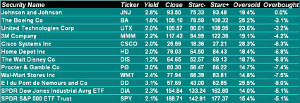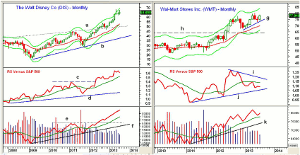With the current bull market getting long in the tooth, along with growing forecasts for a market top and loss of upside momentum, identifying the most overbought Dow stocks is now even more important than ever, says MoneyShow’s Tom Aspray.
The stock market drifted lower for most of Wednesday, even though the GDP data was much better that expected. The FOMC minutes pushed rates lower but the close was mixed with the Dow and S&P 500 lower while the Nasdaq Composite was higher again.
The Asian markets were higher with the Nikkei 225 up 2.4% and the Shanghai Composite up 1.7% on better-than-expected manufacturing data. Stocks in Europe are also showing nice gains with the US futures up sharply as the market waits for the monthly jobs report on Friday.
The number of forecasts for a market top seems to be growing and while there has been a loss of upside momentum, the technical studies have not yet given strong sell signals. Maybe this increase in negative sentiment will be enough to fuel another rally phase. The McClellan oscillator on the NYSE Composite formed a negative divergence at the July 24 highs, but dropped on Wednesday to -45 and is now longer overbought.
In this environment, the monthly starc band scan can often give one additional insight. Oftentimes those stocks that are overbought (closest to their starc+ band) can alert one to stocks that have recently made important turns but can also be used to identify stocks that may be becoming especially vulnerable.
Those stocks that are most oversold (closest to their starc- bands) can isolate those stocks that are in a low-risk buy area but can also be a way to find those stocks that are acting weaker than the overall market. They could also be weaker than the S&P 500 if it declines.
Johnson and Johnson (JNJ) is the most overbought stock as it closed the month just barely above its monthly starc+ band. The Boeing Company (BA) is second as it is 3.1% below its starc+ band. The SPDR Dow Jones Industrial ETF (DIA) and Spyder Trust (SPY) are included for reference as both are 5.1% below their monthly starc+ bands.
The monthly chart analysis can often give you a better idea of the key levels of support and resistance. Those who decide to buy a stock or ETF based on the daily charts should also look at the monthly and weekly chart as they can help to filter out the sometimes misleading signals from the daily chart.
This month’s scan has identified three stocks that look especially vulnerable based on the monthly analysis and one stock looks like it has made a major turn.
Chart Analysis: The Boeing Co. (BA) has been in the news consistently over the past few months regarding is 787 Dreamliner. It has been hugging its monthly starc+ band for the past four months.
- BA broke through major resistance (line a) in April when it closed at $91.41.
- With the July close at $105.10, it has gained 15% since its breakout.
- In July 2007, it hit an all-time high of $107.83.
- The relative performance closed above major resistance at line b in March signaling that it was becoming a market leader.
- The monthly OBV overcame its resistance, line c, at the same time.
- The OBV is well above its uptrend and its WMA, but the weekly is below its WMA so the multiple OBV analysis is now mixed.
- The June low at $96.83 is the first key level of support with the breakout level, line a, now at $92.
Cisco Systems (CSCO) tested its monthly downtrend, line a, in February, March, and April before May’s impressive breakout.
- The tight range in June was followed by a 5.1% gain in July.
- The next resistance from 2010 is in the $27.74 area with the 2007 high at $34.24.
- The relative performance has closed just slightly above the previous highs, line g, indicating that it is in the early phases of becoming a market leader.
- The weekly RS line shows a similar formation, so how it acts when the market corrects could be important.
- The monthly OBV broke its major downtrend, line h, in August 2012 and completed its major bottom by the end of the year.
- The rising 20-week EMA is at $23.60 with the quarterly pivot support at $23.10.
- Another measure of support is midpoint of May’s wide bar at $22.70.
- The rising 20-month EMA is at $20.74 with the former downtrend (line e) just below $20.
NEXT PAGE: 2 More Vulnerable Stocks
|pagebreak|The Walt Disney Company (DIS) is the largest holding in the Select Sector SPDR Consumer Discretionary ETF (XLY), which has done very well this year.
- The monthly chart shows that DIS has been trading very close to its monthly starc+ bands.
- It may be more important that the monthly candles show that for the past three months DIS has closed the monthly nearer to its lows than the highs.
- For example, in May, the high was $67.89 but the close was at $63.08. In July the high was $67.55 with a close at $64.65.
- The relative performance broke through resistance in 2012, line c, and shows a long-term pattern of higher highs.
- The RS line has turned down but is well above its WMA.
- The OBV surpassed its major resistance (line e) and confirmed the breakout in prices above the corresponding resistance, line a.
- The quarterly pivot is at $62.73 with the 38.2% Fibonacci retracement support from the November 2012 lows at $59.80.
Wal-Mart Stores Inc. (WMT) made marginal new highs at $79.96 in the middle of May before correcting to a low of $73.01 on June 20. This was a drop of 8.7%.
- WMT has rallied from the June lows and has reached the quarterly R1 resistance at $78.70 where the rally appears to have stalled.
- The monthly chart shows a short-term uptrend, line g.
- The relative performance did not confirm the late 2012 or May highs as it has formed lower highs, line i.
- The RS line now has important support at line j and a break would confirm the divergence.
- The monthly OBV did confirm the recent highs and shows a very bullish pattern as it has turned up from its rising WMA.
- The quarterly pivot is at $75.88 with monthly pivot support at $74.79.
- The failure of WMT to make a new highs with the market is a sign of weakness.
What it Means: The Boeing Co. (BA), Walt Disney Company (DIS), and Wal-Mart Stores Inc. (WMT) all look vulnerable as their rallies appear to be losing upside momentum.
Cisco Systems (CSCO) also should pull back with the market but the longer-term picture indicates that this should be a buying opportunity.
How to Profit: For Cisco Systems (CSCO), go 50% long at $24.56 and 50% long at $23.44, with a stop at $22.66 (risk of approx. 5.3%).














